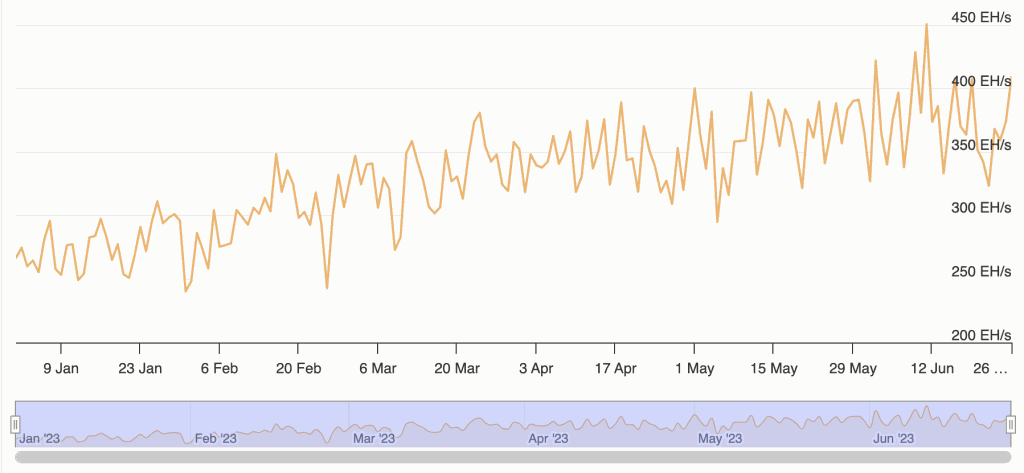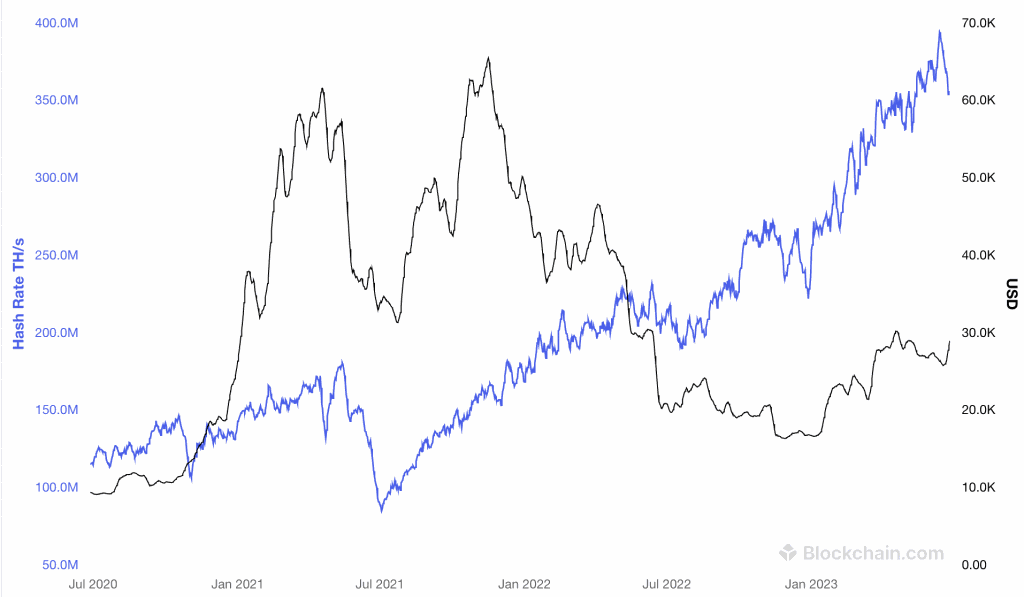If you’ve been delving into Bitcoin (BTC) on your own, you might wonder: what exactly is the “hash rate?” It’s a term frequently used in discussions about Bitcoin mining, but it has also become an intriguing metric for many individuals involved in the market. So, what does it mean, and why is it important? Let’s find out…

Understanding Hash Rate
Hash Rate, called Hash, is a unit of measurement of the computing power of equipment used to mine or mine Bitcoin and other cryptocurrencies. Bitcoin mining involves solving algorithms to confirm transactions, thus requiring powerful equipment that helps find the necessary hash in the shortest time.
Here is the Hash Rate Chart of the Bitcoin Network 01/2023-06/2023

The Hash Rate Chart of the Bitcoin Network 06/2020-06/2023

If an entity has enough computing power to control over 50% of a blockchain‘s mining power, it could block, reorganize, or reverse transactions, making such a network prone to double spending and many other malicious activities. Double spending is a flaw that lets an attacker reacquire a cryptocurrency after spending it, meaning they can spend the same crypto multiple times.
A high crypto network hash rate shows miners are investing in powerful mining equipment and has faith in the project. Therefore, you can see the hash rate as an indicator of the health and security of a network.
When investors see high hash rates, it encourages them to invest in a crypto network. Since we have also mentioned that the hash rate is more like an indicator of the health and security of a network, such a network could be better for investors than one with a low hash rate.
Importance of Hash Rate
The hash rate directly impacts various aspects of the Bitcoin ecosystem:
Network Security:
A high hash rate indicates a strong network security level. With more computational power dedicated to mining, it becomes increasingly difficult for malicious actors to gain control over the network or execute double-spending attacks.
Transaction Confirmation Speed:
As miners compete to solve mathematical puzzles, higher hash rates result in faster block creation times and quicker transaction confirmations. This leads to improved efficiency in transferring Bitcoins from one address to another.
Difficulty Adjustment:
The hash rate is essential in adjusting the difficulty level for mining new blocks. When the total hash rate increases significantly, indicating increased competition among miners, the difficulty level adjusts upwards to maintain an average block time of approximately 10 minutes.
Mining Rewards:
The amount of newly minted Bitcoins awarded to successful miners depends on their contribution to the overall hash rate. Miners with higher hash rates are more likely to earn block rewards, incentivizing them to invest in more powerful mining hardware.
Factors Influencing Hash Rate:
Several factors can affect the overall hash rate of the Bitcoin network:
Mining Hardware:
The type and quality of mining hardware used greatly impact the hash rate. As technology advances, miners constantly seek more powerful equipment to stay competitive. Specialized devices called Application-Specific Integrated Circuits (ASICs) have become popular due to their superior hashing capabilities compared to traditional CPUs or GPUs.
Energy Costs:
Mining Bitcoin requires substantial amounts of electricity due to the computational power needed. The cost of electricity directly affects a miner’s profitability and ability to sustain high hash rates. Miners often seek regions with affordable energy prices or renewable energy sources to maximize their profits.
Difficulty Level:
The difficulty level is adjusted every 2016 block (approximately every two weeks) based on the average time it took for miners to solve the previous blocks. Higher difficulty levels mean more computational power is required to mine new blocks, thus increasing the overall hash rate as miners strive to meet the demands.
Network Participation:
The number of active miners on the network also impacts the hash rate. When there is increased interest in mining Bitcoin, more participants join the network, resulting in a higher total hash rate. Conversely, a decrease in participation can lead to a decline in overall hash rate.
Determination of hash rate
The hash rate is simply the rate at which a particular mining device operates. Finding blocks entails performing intricate computations in cryptocurrency mining. Like a math puzzle, blocks are. To solve the block, miners must make tens of thousands or perhaps millions of guesses each second.
To put it another way, miners should hash the block header so that it is lower than or equal to the target to mine a block properly. Target recall changes as the level of difficulty changes. A “nonce” is a block header that the miner must alter to achieve a particular hash function (or target).
Each starts with “0” and is incremented each time to obtain the necessary hash (or target).
Given that the nonce shift is a game of chance, the chances of getting a certain hash function (or target) are meager. The miner, therefore, has to make multiple attempts by changing the number of openings. The number of attempts a miner makes per second is called hash rate or hash power.
Measurements and Units
One thing to note is that hash rates vary depending on the cryptocurrency and the machine or equipment used to mine it. Different cryptocurrencies don’t have the same amount of hash power.
The hash rate is calculated in hashes per second (h/s). Some common terms used include mega, giga, and tera, depending on the hash amount. For instance, a machine with a rate of 60 hashes per second will make 60 guesses per second when trying to solve a block.
1 kilo hash per second (1 Kh/s) = one thousand hashes per second (1,000 h/s)
1 mega hash per second (1 Mh/s) = one million hashes per second (1,000,000 h/s)
1 Giga hash per second (1 Gh/s) = one billion hashes per second (1,000,000,000 h/s)
1 tera hash per second (1 Th/s) = one trillion hashes per second (1,000,000,000,000 h/s)
1 Peta hash per second (1 Ph/s) = one quadrillion hashes per second (1,000,000,000,000,000 h/s)
1 exa hash per second (1 Eh/s) = one quintillion hashes per second (1,000,000,000,000,000,000 h/s)
Cryptocurrencies use different algorithms and machines for mining with varying hash rates. For example, a Bitcoin mining machine has a different hash rate than Ethereum because they use different amounts of memory and computers for mining.
The relationship between hash rate, mining profitability, and difficulty
There are several relationships between difficulty, profitability for miners, and hash rate. Let’s use Bitcoin as an illustration. The hash rate grows whenever the Bitcoin network’s difficulty does, and as a result, miners earn 12.5 BTC in addition to transaction fees. The difficulty rises as more miners join the Bitcoin network because each miner must make more predictions per second. The difficulty will rise as more people join in, reducing the number of bitcoins found while increasing the profit, which is inversely proportional to the price of bitcoin.
How does the hash rate affect Bitcoin price?
The drivers of Bitcoin’s price are computational power, mining profitability, and network difficulty. Miners receive compensation in Bitcoin but incur costs in local currencies, so the hash rate follows the price.
More computational power increases Bitcoin’s value. Rational miners only mine BTC if it’s profitable, meaning other cryptocurrencies without demand have no value, and miners focus elsewhere.
Network difficulty represents total mining power. The Bitcoin network adjusts the difficulty to compensate for declining or growing mining power.
Bitcoin price fluctuations impact energy consumption and miner behavior. The hash rate and BTC price are believed to be related.
In competitive markets, a producer’s effort doesn’t affect consumer prices. However, this may not be true for Bitcoin due to a few mining pool operators influencing market prices. Additionally, the inelastic supply of Bitcoin and intense mining competition may lead miners to behave differently.

Tools for Tracking Bitcoin Hash Rate
- Blockchain.com offers several graphs and information about Bitcoin, including its overall hash rate. Additionally, you can examine the average block time and difficulty and the distribution of hash rates among various mining pools.
- CoinWarz: This website features a Bitcoin mining profitability calculator that you can use to determine your profitability depending on your hash rate, power usage, and other variables. Additionally, you may view the graphs of the Bitcoin difficulty and hash rate over time.
- YCharts: This website offers a graph of the daily hash rate numbers for the Bitcoin network from 2009 to the present. The hash rate’s percentage change and previous peaks and troughs are also visible.
Conclude
Based on the frequency of new Bitcoin miners joining the network, we have every reason to believe that Bitcoin will last very long. At that point, we should only start to be concerned. This is practically impossible because each miner will benefit greatly from a drop in the overall number of computers by receiving greater payouts. However, it is probably premature to predict that Bitcoin will reach a new peak based solely on hash rate; widespread acceptance and usage are also necessary factors.


